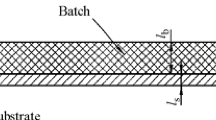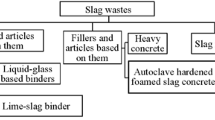Optimal compositions for the synthesis of foamed glass using slag wastes from thermal power plants TPP — foamed slag glass — were developed. Software for modeling the foaming process was developed on the basis of experimental data; this software makes it possible to determine the structure of the foamed slag glass without performing additional experimental studies.


Similar content being viewed by others
Notes
Here and below, the weight content, %.
References
Approval of the Requirements of Energy Efficiency of Buildings, Structures, and Works: Order No. 224, Dated May 17, 2011 [in Russian], Ministry of Regional Development of the Russian Federation, Moscow (2011).
E. A. Yatsenko, A. P. Zubekhin, V. A. Smolii, et al., “Resourceconserving technology of heat-insulation-decorative glass composite material based on ash-slag wastes,” Steklo Keram., No. 6, 34 – 38 (2015); E. A. Yatsenko, A. P. Zubekhin, V. A. Smolii, et al., “Resource-conserving technology of heat-insulation-decorative glass composite material based on ash-slag wastes,” Glass Ceram., 72(5 – 6), 216 – 219 (2015).
V. A. Smolii, E. A. Yatsenko, A. S. Kosarev, and B. M. Gol’tsman, “Development of compositions and technological parameters for the synthesis of cellular glass heat-insulation construction materials with prescribed density,” Steklo Keram., No. 6, 22 – 25 (2016); V. A. Smolii, E. A. Yatsenko, A. S. Kosarev, and B. M. Gol’tsman, “Development of compositions and technological parameters for the synthesis of cellular glass heat-insulation construction materials with prescribed density,” Glass Ceram., 73(5), 219 – 221 (2016).
B. M. Gol’tsman, “Effect of pore formation agents on the properties of foamed slag glass,” Nauch. Obozrenie, No. 21, 102 – 105 (2015).
V. A. Smolii, A. S. Kosarev, E. A. Yatsenko, and B. M. Gol’tsman, “Development of production technology for efficient energy-saving cellular heat-insulating construction glass material,” Izv. Vyssh. Uchebn. Zaved., Severo-Kavkaz. Region, Ser. Tekh. Nauki, No. 4(185), 128 – 132 (2015).
F. Schill, Foam Glass [in Russian], Stroiizdat, Moscow (1965).
B. K. Demidovich, Foam Glass [in Russian], Science and Technology, Minsk (1975).
N. I. Minko, O. V. Puchka, B. S. Bessmertnyi, et al., Foam Glass: Scientific Principles and Technology [in Russian], Nauchn. Kniga, Voronezh (2008).
This scientific research work is supported by a President of the Russian Federation stipend awarded to young scientists and graduate students performing promising scientific research and development work of high-priority for the modernization of the Russian economy (competition 2016 – 2018).
Author information
Authors and Affiliations
Corresponding author
Additional information
Translated from Steklo i Keramika, No. 8, pp. 9 – 11, August, 2017.
Rights and permissions
About this article
Cite this article
Yatsenko, E.A., Gol’tsman, B.M., Yatsenko, L.A. et al. Application of Computer Technologies for Modeling the Process of Formation of the Porous Structure of Foamed Glass. Glass Ceram 74, 267–269 (2017). https://doi.org/10.1007/s10717-017-9976-2
Published:
Issue Date:
DOI: https://doi.org/10.1007/s10717-017-9976-2




